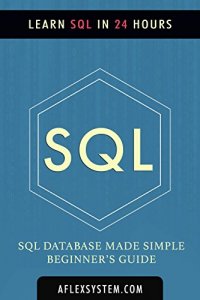SQL: SQL Guide – Learn SQL In 24 hours or less
*** Reading this book is like downloading new software into your brain! Get this SQL kindle book if you want to learn SQL! It all starts here ***
SQL Guide – Learn SQL In 24 Hours Or Less is a book for beginners to dive deep right into this querylanguage with examples. No prior knowledge of SQL required.
SQL is a very popular query language and will continue to be so, however, it can be overwhelming. This book brings you a concise, straight to the point, easy to follow code examples with screenshots so you can begin using SQL in less than 24 hours. Invest in yourself, practice SQL and you will be an SQL expertin no time.
Here are some topics of what you’ll learn inside:
Table of Contents
Chapter 1: Introduction to SQL
1.1 Relational Databases
1.2 Database Management Systems
1.3 Relational Database Management Systems
1.4 Tables
1.5 Relationships
1.6 Primary Keys and Foreign Keys
1.7 SQL
1.8 A Brief History of SQL
Chapter 2: SQL Statements
2.1 Classification
2.2 CREATE Statement
2.3 INSERT Statement
2.4 UPDATE Statement
2.5 SELECT Statement
2.6 DELETE Statement
Chapter 3: Data Definition Language
3.1 DDL and ANSI/ISO standards
3.2 Create Table
3.3 Table Modifiers
3.4 Alter Table
3.5 Drop Table
Chapter 4: Querying the Database
4.1 The simplest “SELECT” query
4.2 Computed Columns
4.3 WHERE clause
4.4 ORDER BY clause
Chapter 5: SQL Functions
5.1 COUNT Function
5.2 SUM Function
5.3 AVG Function
5.4 MAX Function
5.5 MIN Function
5.6 GROUP BY clause
5.7 HAVING clause
Chapter 6: Joins and Subqueries
6.1 Inner Join
6.2 Left Outer Join
6.3 Right Outer Join
6.4 Self Join
6.5 Subqueries
Chapter 7: Views in SQL
7.1 Definition of Views
7.2 Advantages of using Views
7.3 Create Views
7.4 Vertical Views
7.5 Horizontal Views
7.6 Updating Views
7.7 Drop Views
Chapter 8: Stored Procedures
8.1 Advantages of using Stored Procedure
8.2 Create Stored Procedure
8.3 Execute a Stored Procedure
Chapter 9: Cursors and Trigger
9.1 Cursors
9.2 Triggers
9.3 Create Trigger
9.4 Advantages of Triggers
Chapter 10: Database Security
10.1 SQL Privileges
10.2 Log in Credentials
10.3 Grant and Revoke
10.4 The PUBLIC keyword
Chapter 11: Transactions and Transaction Levels
11.1 Transaction
11.2 COMMIT and ROLLBACK statements
11.3 Transactions from Multiple Users
11.4 Data Locking
11.5 Deadlocks
11.6 Properties of Transactions
11.7 Isolation Levels
Chapter 12: SQL Server Index Structures
Chapter 13: Query Optimization
13.1 Indexing
13.2 TSQL Code in Database Server
Don’t wait! Learn SQL right away and enter the world of database.
Scroll Up To The Top Of The Page And Click The Orange –> “Buy Now”












